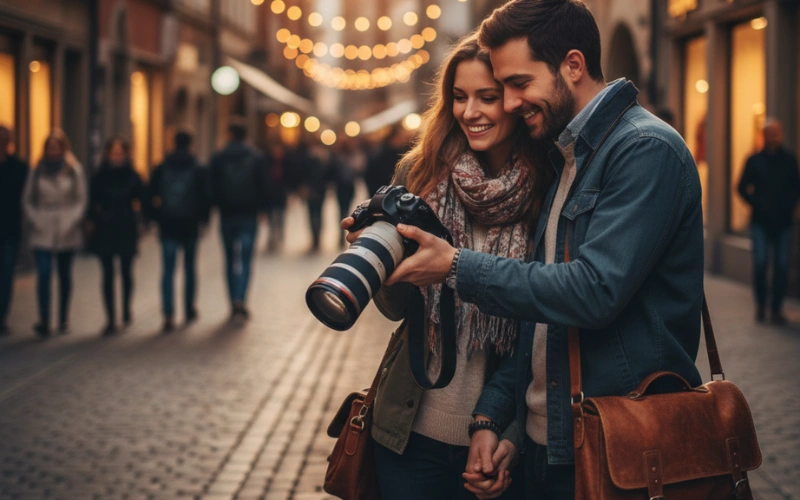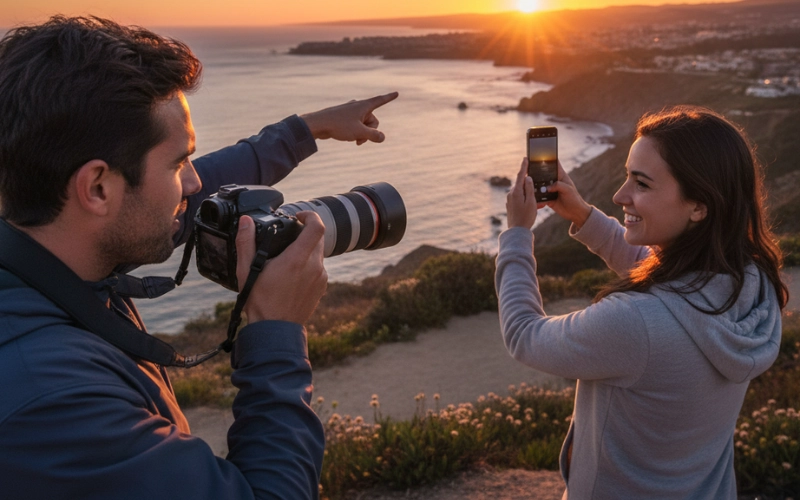Travel Photography Tips – Capture Your Journey Like a Pro
Published: 09/10/2025
Travel and photography are like best friends. You can’t imagine one without the other. Every trip gives us moments we never want to forget, and photos are the easiest way to keep them alive. A single shot can capture the colors of a busy street, the calm of a mountain view, or the smile of a stranger you met on the way.
The good news is you don’t need expensive gear to do this. Whether you carry a DSLR with big lenses or just a smartphone in your pocket, you can still tell powerful stories through pictures.
In this guide, I’ll share easy and practical travel photography tips that work for everyone, from first-time travelers to photo lovers.
So, let’s start.
Why Travel Photography Matters
Travel is not just about going to new places; it’s about saving moments you want to remember for life. The truth is, memories fade with time, but photos keep them fresh. Travel photography matters because it turns short trips into stories you can hold on to.

Family travel photography tips are helpful because family trips are full of laughter, surprises, and little adventures. Capturing these moments means you have more than just pictures in an album; you have memories to pass on to the next generation.
For people who like traveling alone, solo travel photography tips make the journey more meaningful. Every photo you take becomes part of your personal diary, showing both the places you visited and the feelings you had at that time.
Whether with family or alone, travel photography connects your experiences with memories that never fade.
Best Travel Photography Tips for Beginners
You don’t need expensive gear or years of experience to capture beautiful travel photos. Even with a basic camera or smartphone, small changes in how you shoot can make your pictures look more professional and meaningful. Here are some beginner-friendly tips to keep in mind:
Use natural light
Early morning and late afternoon are called the “golden hours.” The light during these times is softer and warmer, which makes landscapes glow and portraits look natural.
Follow the rule of thirds
Think of your photo divided into nine equal parts, like a grid. Instead of placing your subject in the center, try positioning it along one of the lines or corners. This adds balance and makes the photo more eye-catching.
Experiment with angles
Don’t stick to the usual standing shot. Crouch low to capture ground details, climb a small step for a higher view, or tilt your camera for a creative frame. New angles often tell a stronger story.
Be patient and observant
Travel photography is not only about clicking quickly. Sometimes waiting a few seconds gives you the perfect shot, a bird spreading its wings, a child laughing, or a wave crashing on the rocks.
These are some of the best travel photography tips for beginners. With practice, you’ll notice how small adjustments bring more life and emotion into your photos.
DSLR vs Smartphone Travel Photography
Many people ask: Should I travel with a DSLR camera or just use my phone? The answer is simple: both are useful in different ways.
DSLR cameras – These give very clear photos, work well in low light, and let you use zoom or wide lenses. You can control every setting, which is good if you are serious about travel photography.

Smartphones – Phones are light, easy to carry, and always ready. Modern phones, like iPhones, Samsung, Google Pixel or etc, have strong cameras with editing tools and are great for quick sharing. That’s why iPhone travel photography tips are so popular.
The smart choice is to use both. Take your DSLR for big views like mountains or sunsets, and use your phone for family selfies, solo travel photos, or quick street moments.
Solo vs Family Travel Photography Tips
Traveling alone and traveling with family give very different kinds of photos.
Solo travel photography tips
If you travel alone, try to include yourself in the story, not just the scenery. A small tripod or your phone’s timer can help. Reflections in windows, shadows on the ground, or wide shots with you in the frame make your photos feel more personal.
Family travel photography tips
With family, focus on real moments, not just formal group shots. Capture smiles, kids playing, or grandparents enjoying tea at a café. A wide lens is helpful to fit everyone in, but don’t forget small details that show the joy of the trip.
Both styles bring warmth and personality to your photos, whether you are telling your own story or your family’s.
Exotic Travel Photography Tips and Tricks
Travel photography is not only about famous spots; exotic places like mountains, deserts, beaches, or local markets give you richer stories. Here are some useful tips:
- Be respectful when photographing people; always ask before taking a picture.
- Use wide-angle lenses to capture big landscapes.
- Focus on details like street food, handmade items, or colorful clothes.
- Edit your photos lightly to improve colors, but avoid making them look fake.
These simple travel photography tips and tricks help you capture not just the beauty of a place but also its culture and everyday life.
Small changes in how you shoot or handle your camera can make your travel photos look much better. Here are some easy techniques:
- Shoot in RAW – If your camera or phone allows it, use RAW format. It saves more detail and gives you full control during editing.
- Use HDR mode – For bright sunsets, mountains, or city lights, HDR helps balance light and dark areas so your photo looks more natural.
- Edit smartly – Use free apps like Lightroom Mobile or Snapseed to fix brightness, colors, and contrast. Edit lightly so photos still look real.
- Keep backups – Save your photos in the cloud, on a hard drive, or even both. It’s the safest way to protect your memories.
- Clean your lens – Dust and fingerprints can ruin photos. Wipe your phone or DSLR lens with a microfiber cloth before shooting.
- Use a steady hand (or tripod) – Blurry photos happen when your camera shakes. Hold your camera steady or use a tripod for sharper shots.
- Play with leading lines – Roads, rivers, or bridges can guide the viewer’s eye into your photo. This simple trick makes pictures more powerful.
- Include people for scale – Adding a person in a big landscape shows how large and impressive the place really is.
- Frame the subject – Use windows, doors, or natural elements like trees to frame your subject. It makes the photo more creative.
- Wait for the right moment – Sometimes patience gives you the perfect shot, a clear street, a bird flying, or the perfect wave.
These travel photography tips and techniques not only make your photos look professional but also ensure they tell stronger and more memorable stories.
How to Tell Stories with Travel Photos
Good travel photography is more than just showing places. It is about telling a story. A solo traveler’s photo can show freedom and adventure. A family photo can show warmth, love, and togetherness.
- Capture local traditions and people.
- Mix wide shots with close details.
- Write captions that explain the photo.
Photography and traveling together give you the power to share experiences, not just images.
| Quick Smartphone Travel Photography Tips |
|---|
|
Not everyone owns a DSLR. In fact, most travelers today use their phones. Here are some easy iPhone travel photography tips (they work on Android too):
These simple tips for travel photography with smartphones can make your shots look much sharper and creative. |
Final Thoughts
Travel photography is not about having an expensive camera or knowing complicated settings. It’s about noticing the little things, enjoying the moment, and capturing memories you can look back on with a smile. Even with a phone, you can take pictures that tell your story.
Whether you use a DSLR or smartphone, these travel photography tips can help you capture your journey in photos. Remember to enjoy your trip, be kind to people around you, and let your pictures show what you saw and felt.
Which travel photography tip do you use the most? Share your favorite trick in the comments!
Frequently Asked Questions about Travel Photography
Not really. A DSLR gives sharp images and more control, but smartphones today can also take amazing pictures. If you learn simple travel photography tips and tricks, even your phone can produce professional-looking shots.
Always clean the lens, hold your phone steady, and use natural light. For even better results, try iPhone travel photography tips like turning on HDR and using portrait mode for people or food.
Early morning and sunset are the best times, also called the golden hours. The soft light makes landscapes glow and gives a warm tone to portraits. Many tips for better travel photography start with good light.
Solo travelers can use a tripod, a self-timer, or a remote shutter. Creative ideas include reflections in windows, shadows on the ground, or wide shots with you in the corner. These small solo travel photography tips make your pictures feel more personal.
Don’t only click group poses. Capture candid laughs, children playing, or family members enjoying food. Wide lenses help fit everyone into the frame. These family travel photography tips create memories you’ll cherish for years.
Use the rule of thirds, try unique angles, and edit lightly with apps. Shooting in RAW (if possible) also helps. These small travel photography tips and techniques give your photos a polished look.
Yes, they can improve your pictures without making them fake. Apps like Lightroom and Snapseed are beginner-friendly. A little adjustment in brightness, contrast, and colors can bring your photography travel shots to life.
Always carry extra memory cards and batteries. Back up your photos daily on cloud storage or an external hard drive. Following these travel photography tips and tricks keeps your memories safe.
Exotic places like beaches, mountains, or markets need wide shots for scenery and close-ups for details. Capture culture with respect, ask before clicking locals. These exotic travel photography tips help your photos stand out.
Think of your photos as a book. Use wide shots to set the scene, medium shots for activities, and close-ups for emotions or food. Mixing these makes your travel photography a complete story of your journey.

- Be Respectful
- Stay Relevant
- Stay Positive
- True Feedback
- Encourage Discussion
- Avoid Spamming
- No Fake News
- Don't Copy-Paste
- No Personal Attacks

- Be Respectful
- Stay Relevant
- Stay Positive
- True Feedback
- Encourage Discussion
- Avoid Spamming
- No Fake News
- Don't Copy-Paste
- No Personal Attacks
